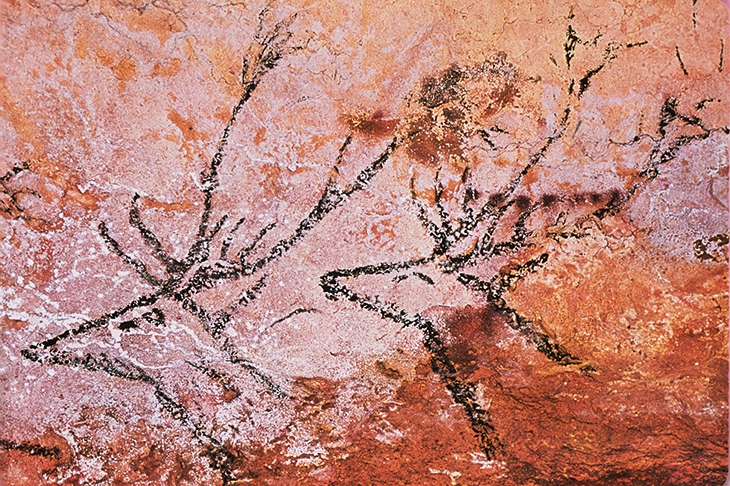‘It was a shock, and an epiphany,’ says Fiona Sampson, to realise that many of her favourite places were built on and out of limestone: the cosy Cotswold village of Coleshill, the shambolic hamlet of Le Chambon in the Dordogne, the limestone Karst region of western Slovenia, and the honeycombed hills of Jerusalem and the Holy Land. ‘Surely, I thought, this has to be more than mere coincidence.’
From a strictly demographic point of view, it isn’t even much of a coincidence: about one quarter of the world’s population lives in limestone country or depends on it for its water. But the mind of a poet can feed on the slightest chance connection. While her neighbours in Coleshill go about their spongy, fossil-filled environment with nary a thought of ‘chthonic forces’, Sampson inhabits a half-soluble landscape of subterranean streams and geopathic stress created by the compacted shells and skeletons of primeval sea-creatures.
A professor of poetry and champion of creative writing as a therapeutic tool, Sampson fortunately finds other people as interesting as herself. This ‘personal exploration’ of the ways in which a mind interacts with a landscape might have been a gallery of psycho-geographical selfies in picturesque settings; which, to some extent, it is. She relives an early love affair with a chain-smoking Macedonian in the ‘intractable, dense and mysterious’ Slovenian Karst and observes her past and present selves ‘trying on possible ways of living — or dying — in limestone country’. But this geologically themed nature walk swarms with objective facts, and the limestone itself hardly matters. A digressive and polymathic tour-guide, Sampson has little time for the famous attractions of sedimentary rock — all those boring caverns with their tediously intrepid potholers and weird formations with silly names: ‘surely these attempts to make them more interesting are an admission of dullness?’
This bewitching little book, which might have been designed to sit prettily in a lime-washed cottage, is a long after-dinner causerie on 1,000 different topics: vegetable gardening, domestic plumbing, ludicrous peasant lore, Galilean ornithology, the National Trust and the Chicxulub extinction event. ‘The psyche’s like a carrier bag loaded with too many groceries that first splits, then bursts as you lift it out of the car.’ ‘It’s as if the self can’t contain the significance of the place.’
Rooting through the spilled shopping is an engrossing and informative experience. The chapter on Le Chambon, where she and her partner contentedly spend half the year, is an unusually realistic description of a tatty hamlet in la France profonde. This is not the vulgar dream of idleness which Francophile magazines refer to as ‘the French way of life’. Le Chambon does have the obligatory ‘time-stopped feeling’ and the picture-postcard views — the apricot mist, the white hair and rosy cheeks of the farmer next door — but above it all is the constant, inexplicable din: the snarl of dogs and chainsaws, the screech of poultry, the slamming of car doors and wooden shutters, the pointless yelling over short distances. The hamlet deserves the epithet ‘sleepy’ only in the aftermath of the regular neighbourly feast of foie gras and truffles, roasted goose and lardy spuds, bowls of chocolate, butter-sodden pastries and staggeringly potent homemade wine. Then comes the brief silence of communal indigestion and alcoholic stupor, while the traditional rustic bonfire fills the air with the smells of unseasoned wood and tractor tyres doused in petrol.
Even 200 years ago, British travellers to deepest France remarked on this incongruous cacophony. This might support Sampson’s contention that stone creates a certain way of life. In impervious granite country, water stays close to the surface; in porous limestone country, it seeps away underground and the human population tends to be more sparse. To a native, the noise apotropaically fills the wide spaces between the scattered settlements. Le Chambon lies only 25 km from the caves of Lascaux. Those palaeolithic wall paintings might have been an offering to gods of the sedimentary underworld, but perhaps the prehistoric artist was simply desperate for peace and quiet. Another system of limestone caves was recently discovered near Le Chambon, and it is no surprise to learn that the mazy caverns are now filled with the sound of ‘electro-drumming’ and ‘disco glows of pink, blue and green’.
Back in sleepy Coleshill in the west Oxfordshire Cotswolds, there are roaring water pipes, the pervasive thrum of amateur bell-ringing (so far and yet so near), the humming of tin-roofed grain-dryers and ‘the continual soughing of the M4’. Sampson and her partner, both writers, must have the most amazing powers of concentration, unless this carrier bag of aperçus is the poet’s wise accommodation with distraction. Perhaps there is, after all, something in the limestone — the subtle solidity of those extinct organisms and the almost inaudible murmur of subterranean streams.






Comments